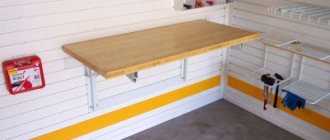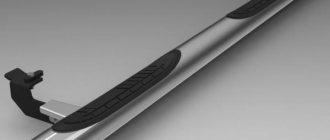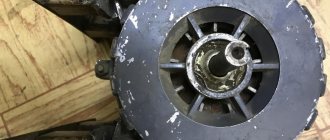On the hub, various interesting posts are increasingly appearing about how someone assembled another steam engine, or some kind of device powered by steam. This is understandable, at some point everyone gets tired of being hypnotized by the monitor, and the soul asks for the sea, adventure and romance, but with an engineering approach. What could be more romantic than a steam engine, and even one installed on a ship? Since there is no way to develop a full-fledged shipyard in the asphalt jungle, you can have some fun on the table. Here I’ll tell you about some of my experiments, as well as what I managed to dig up on the Internet.
The master made the steam engine himself
Have you ever seen how a steam engine works, not on video? Nowadays, it is not easy to find such a functioning model. Oil and gas have long replaced steam, taking a dominant position in the world of technical installations that set mechanisms in motion. However, this craft is not lost; you can find examples of successfully working engines installed by craftsmen on cars and motorcycles. Homemade samples more often resemble museum exhibits than elegant, laconic devices suitable for use, but they work! And people successfully drive steam cars and set various units in motion.
In this episode of the “Techno Rebel” channel you will see a steam two-cylinder machine. It all started with two pistons and the same number of cylinders. Having removed all unnecessary things, the master increased the piston stroke and working volume. Which led to an increase in torque. The most difficult part of the project is the crankshaft. Consists of a pipe that has been bored for 3 bearings. 15 and 25 pipes. The pipe is cut down after welding. Prepared a pipe for the piston. After processing it will become a cylinder or spool.
Leave 1 centimeter from the edge on the pipe so that when the lid is welded, the metal may move to the side. The piston may get stuck. The video shows the modification of the timing cylinders. One of the holes is plugged and narrowed to a twenty tube. Steam will come in here. Steam outlet.
How the device works. Steam is supplied to the holes. It is distributed through the pipe and enters 2 cylinders. When the piston moves down, steam passes through and falls under pressure. The piston rises. Blocks the passage. Steam is released through the holes. Next from 5 minutes
DIY FRIEND
Dear visitors to the SAMODELKINDRUG website, in the article presented to your attention we will talk about a steam-powered vehicle. We will go “Back to the Future”, and the Craftsman from the Sovetsky District and his channel on YouTube will help us with this. Namely, what the guy managed to do was that he and his friends made a “PAROTRIK”, that is, a trike with a steam engine. All spare parts, components and assemblies were taken from scrap metal; only a pressure gauge and half-turn valves were purchased. The basis was taken from the developments of the last century, when steam engines were the “engine of progress”. The principle of operation of a steam engine is quite simple) The basis is a boiler with water, when heated, water vapor is released, excess pressure is created, which enters the cylinder through a steam line and pushes the piston, and he, in turn, pushes the flywheel or the wheel at once, then the piston reaches a certain point where the relief valve is located and through it the steam escapes to the outside, thereby freeing the cylinder chamber for the next portion of steam. For clarity, let's look at a simple diagram (of a steam locomotive). Here's also another diagram for greater clarity, although it's the same here. As you can see from the drawing, everything is quite simple, only the author made his boiler in comparison with a steam locomotive, as if miniature, for which he needed waste gas cylinders for domestic use, with a wall thickness of 4 mm, the operating pressure at which the trike could easily move and develop speed 3-4 bar
Again, let's go back a little to history, at the very beginning of the development of steam engines, engineers tried to create self-propelled crews and this is what they did.
Gradually, this direction gained support among the public and development began. And now a more modern steam-powered carriage, more or less similar to a car.
And so the basis is naturally a steam boiler, in which water acquires a vapor state and then flows through pipes to the pistons. The heated steam then enters the cylinders and pushes the piston. The piston in turn moves the flywheel or wheel. Everything is very clear with the operation of the steam engine and the design of the boiler, now let’s look at how the author created his “STEAM TRIKE”. To begin with, a frame was made, designed for three wheels (trike). The wheels were used from the Ural motorcycle, as well as the limbers. The steering is from a VAZ. One piston with a sleeve is used from a diesel tractor with a volume of more than 2.5 liters, and the second is bored out from a Minsk motorcycle. Next, a boiler is installed on the resulting frame and connected by tubes to the cylinders. This is the trip “Back to the Future”
How to make a working model of a steam engine at home
If you have been interested in model steam engines, you may have already checked them out online, the shocking thing is that they are very expensive. If you are not expecting the price range, then you can try to look for other options where you can have your own steam engine model. This doesn't mean that you only need to buy them, as you can make them yourself. You can watch the process of creating your own steam engine model at WoodiesTrainShop.com. There's nothing you can't do and find out without doing a little research of your own.
How to build your own steam engine?
It sounds amazing, but you can actually build a model steam engine from scratch. You can start by building a very simple tractor pulled by an engine. It can easily carry an adult and will take you about a hundred hours to complete construction. The great thing is that it is not that expensive and the process of making it is very simple and all you have to do is drill and work on the lathe all day. You can always check out your options at WoodiesTrainShop.com where you'll find more information on how you can get started making your own model steam engine.
The rear wheel rims are homemade, the steam engine model is made from gas cylinders, and you can buy ready-made gears as well as drive chains from the market. The simplicity of the DIY steam engine model is what makes it appealing to everyone as it offers you very simple instructions and quick assembly. You don't even need to learn anything technical to be able to do everything yourself. Simple drawings and pictures are enough to help you with your workload from start to finish.
Read also: How to adapt a throttle valve Vasya diagnostician
The steam engine began its expansion at the beginning of the 19th century. And already at that time, not only large units were built for industrial purposes, but also decorative ones. Most of their customers were rich nobles who wanted to amuse themselves and their children. After steam units became a part of society, decorative engines began to be used in universities and schools as educational models.
Pages
Questions can only be asked after registration. Please login or register.
STEAM ENGINE FROM AN OLD ENGINE
Nowadays it is not customary to stand on ceremony with retired cars. You can take it into the forest away from home and throw it to “be devoured” by microorganisms. If you're lucky, it will be scrapped or melted down. As for the body and other parts, perhaps they are no longer worthy of a better fate. But don’t get too excited about the internal combustion engine, it will still serve you. “It’s time to switch to steam traction,” our lords-inventors from Ryazan believe. The problem of energy supply is familiar to many. Especially in rural areas, in villages, in remote areas, where the voltage in the network, if it exists at all, rarely rises slightly above 150 V, or even disappears completely, tormented by ice and winds, worn-out networks, transformers, rotten supports, etc. With such a meager supply, household appliances do not work or quickly break down, heaters become ineffective, and the computer is in complete trouble. Of course, there is a way out - mobile generators running on gasoline or diesel fuel. It just costs a lot: both the unit itself and especially the fuel. Once upon a time, at the start, the internal combustion engine rapidly overtook the steam engine in several important parameters. Efficiency, compactness, quick start forced motorists to put up with the high cost of fuel. To reduce noise, sophisticated muffling systems had to be developed. The extremely unfavorable traction characteristics of internal combustion engines resulted in the use of expensive and heavy gearboxes and transmissions. And yet... The last (unfortunately) steam car of the American company “Doble”, produced in the 30s. last century, had amazing characteristics. By smoothly turning the throttle valve, the driver could regulate the speed so gently that passengers did not notice the acceleration and braking. But it was possible to accelerate the car so sharply that the tires burst. The same range of speed control was completely preserved in reverse. Moreover, just touching the pedals was enough to switch from full forward to full rear. Such amazing properties of a steam car are obtained automatically, as a result of the extremely favorable traction characteristics of a steam engine, capable of creating high torque on the wheels at low speeds. And although the steam engine still remains on the margins of technological progress, it is these qualities that arouse the growing interest of both fans and inventors. Evidence of this is the emergence of new patents in the field of steam technology. It is reported, for example, about the development of the American inventor Williams. His steam car has no clutch, no gearbox, no starter. A simple turn of the valve is enough for 10 seconds. accelerate the crew to 100 km/h. Steam engine power 230 hp. at 4800 rpm. Maximum speed 280 km/h. Just 50 liters of water is enough for 1500 km. The Russian inventor N. Egin managed to combine both concepts in one unit: a steam engine and an internal combustion engine. It turned out that any internal combustion engine operates reliably from a suitable steam generator. To do this, it is enough to make a simple spool device for supplying steam to the cylinders - and please, remove the power from the crankshaft. It can be done directly or in a more universal way - using an electric generator. Even a very battered internal combustion engine feels great in its new role. The fact is that the engine rotation speed is now only 1000 rpm. Compare with 5-6 thousand for engines of modern cars. But not only moderate speeds are the reason for the phenomenal reliability of the steam installation. The temperature in the cylinders of the car is 5-6 times lower than in the internal combustion engine. Steam, unlike a flammable mixture, does not explode or destroy the piston, but, expanding, gently presses on it. Hence the smooth running and low requirements for materials and tolerances. In the new concept, N. Egin uses his other important invention as a steam generator - thermal thermochemical units (THU) (IR, 12, 07). The basis of the TCU is a high-quality cast-iron steam boiler that does not wear out. Such boilers are still made in Russia. There are also plenty of used internal combustion engines: motorcycles, Muscovites, Volgas, Zhigulis, locomotives and marine diesel engines. The range of old internal combustion engines covers all reasonable needs: from 1 kW for a garden house to 2 MW, providing heat and electricity to an entire village. Such large powers can be obtained if a Russian-made turbine, for example a radial type, is connected to a TCU boiler with an operating pressure of 7-9 atm. It combines the highest reliability (60 thousand hours before repair) with a price that is an order of magnitude lower than that of foreign analogues. The idea of bringing back into service the colossal resource of old internal combustion engines looks truly revolutionary. They didn’t even think of this in the homeland of the steam engine, where even lords are members of clubs of numerous steam engine lovers and admirers. Not only a car engine, but also a powerful diesel engine that has spent its time in production can be turned into a steam engine, thereby saving tons of diesel fuel. And in the remote outback, where fuel can only be delivered by helicopter, this is a real salvation. The most significant disadvantages of steam traction are considered to be high weight and low efficiency. Naturally, it becomes more profitable at powers of about 800 hp, when the heat of the exhaust steam can be used for heating or technological needs. These are the requirements for tractors and all-terrain vehicles in the Far North. And the tandem of ICE and TCU (remember, these are thermal thermochemical units “ERA”) maximally expands the model range and actually fits into the dimensions of a modern car. As for efficiency, a steam engine with its low steam temperatures cannot compare with an internal combustion engine in terms of fuel consumption per kilometer. But the boiler can be heated with either peat or straw, and “ERA” will be happy with both plastic and old galoshes. According to the inventor's calculations, the costs of converting the internal combustion engine to steam engine mode will be recouped in six months. You are provided with a power source with a power of 1-25 kW and cleanliness for 20-25 years. Landfills can become a strategic energy resource. There is already a company that designs such “steam locomotives” to order, but this is a drop in the bucket. N. Egin believes that from declarations and endless experiments with non-traditional energy sources in Russia, it is necessary to move on to expert technical and economic assessment of them in entire industries, for example housing and communal services, and begin systematic implementation. E. Rogov
Steam engines of modern times
At the beginning of the 20th century, the relevance of steam engines began to decline. One of the few companies that continued to produce decorative mini-engines was the British company Mamod, which allows you to purchase a sample of such equipment even today. But the cost of such steam engines easily exceeds two hundred pounds sterling, which is not so little for a trinket for a couple of evenings. Moreover, for those who like to assemble all sorts of mechanisms on their own, it is much more interesting to create a simple steam engine with their own hands.
The engine design is very simple. The fire heats a pot of water. Under the influence of temperature, water turns into steam, which pushes the piston. As long as there is water in the container, the flywheel connected to the piston will rotate. This is a standard diagram of the structure of a steam engine. But you can assemble a model with a completely different configuration.
Well, let's move on from the theoretical part to more exciting things. If you are interested in doing something with your own hands, and you are surprised by such exotic machines, then this article is just for you, in which we will be happy to talk about various ways of how to assemble a steam engine with your own hands. At the same time, the process of creating a mechanism itself gives joy no less than its launch.
Result
The result should be the following design. Water is poured into a small jar, which flows through a hole in the bottom into a copper tube. A fire is lit under the spiral, which heats the copper container. Hot steam rises up the tube.
In order for the mechanism to be completed, it is necessary to attach a piston and flywheel to the upper end of the copper tube. As a result, the thermal energy of combustion will be converted into mechanical forces of rotation of the wheel. There are a huge number of different schemes for creating such an external combustion engine, but in all of them two elements are always involved - fire and water.
In addition to this design, you can assemble a Stirling steam engine with your own hands, but this is material for a completely separate article.
Method 1: DIY Mini Steam Engine
So, let's begin. Let's assemble the simplest steam engine with our own hands. Drawings, complex tools and special knowledge are not needed.
To begin with, take an aluminum can from any drink. Cut off the lower third from it. Since the result will be sharp edges, they must be bent inward with pliers. We do this carefully so as not to cut ourselves. Since most aluminum cans have a concave bottom, it is necessary to level it. It is enough to press it tightly with your finger to some hard surface.
At a distance of 1.5 cm from the top edge of the resulting “glass”, you need to make two holes opposite each other. It is advisable to use a hole punch for this, since it is necessary for them to be at least 3 mm in diameter. Place a decorative candle at the bottom of the jar. Now we take regular table foil, crumple it, and then wrap our mini-burner on all sides.
Steam conquers the world
Newcomen's steam engine, first installed in 1712.
It was a real breakthrough. Rotational motion could find a much wider range of applications. From the crankshaft, drive belts can be used to transmit motion to weaving and other machines. Now steam could make the wheels of self-propelled carriages spin.
The first attempts to use steam to create new means of transportation were made in the 70s of the 18th century. These machines moved on roads, but it would not be long before people found another use for the steam engine—railroads. Watt lived until 1819 and could see the beginning of the Industrial Revolution that his invention spurred, but he did not live six years before the dawn of the railroad era.
Mini nozzles
Next, you need to take a piece of copper tube 15-20 cm long. It is important that it is hollow inside, since this will be our main mechanism for setting the structure in motion. The central part of the tube is wrapped around the pencil 2 or 3 times to form a small spiral.
Now you need to place this element so that the curved place is placed directly above the candle wick. To do this, we give the tube the shape of the letter “M”. At the same time, we bring out the areas that go down through the holes made in the jar. Thus, the copper tube is rigidly fixed above the wick, and its edges act as a kind of nozzle. In order for the structure to rotate, it is necessary to bend the opposite ends of the “M-element” 90 degrees in different directions. The design of the steam engine is ready.
Read also: Spring for automatic trunk opening
Principle of operation
The process goes as follows. After turning on the ignition, power begins to flow from the battery of the three engines. From the first, a blower is put into operation, pumping air masses through the radiator and transferring them through air channels to a mixing device with a burner.
At the same time, the next electric motor activates the fuel transfer pump, which supplies condensate masses from the tank through the serpentine device of the heating element to the body part of the water separator and the heater located in the economizer to the steam generator. Before starting, there is no way for steam to get to the cylinders, since its path is blocked by a throttle valve or spool, which is controlled by the rocker mechanics. By turning the handles in the direction necessary for movement and slightly opening the valve, the mechanic puts the steam mechanism into operation. The exhaust vapors flow through a single collector to a distribution valve, where they are divided into a pair of unequal shares. The smaller part enters the nozzle of the mixing burner, mixes with the air mass, and is ignited by a candle. The resulting flame begins to heat the container. After this, the combustion product passes into the water separator, and moisture condenses and flows into a special water tank. The remaining gas escapes out.
The second part of the steam, larger in volume, passes through the distributor valve into the turbine, which drives the rotor device of the electric generator. Next, the vapors pass into the nozzle part of the condenser, then into the radiator, in which they are cooled, transferring thermal energy to the air, and enter the water tank.
Engine starting
The jar is placed in a container with water. In this case, it is necessary that the edges of the tube are under its surface. If the nozzles are not long enough, you can add a small weight to the bottom of the jar. But be careful not to drown the entire engine.
Now you need to fill the tube with water. To do this, you can lower one end into the water, and draw in air with the other as if through a straw. We lower the jar into the water. Light the candle wick. After some time, the water in the spiral will turn into steam, which, under pressure, will fly out of the opposite ends of the nozzles. The jar will begin to rotate in the container quite quickly. This is how we made our own steam engine. As you can see, everything is simple.
Piston motor
Modern steam engines can be divided into several groups:
- with a direct-flow steam generator device and torch heating;
- with the formation of steam inside the cylinders during torch heating;
- with thermal batteries;
- combined type.
Structurally, the installation includes:
- starting device;
- two-cylinder power unit;
- steam generator in a special container equipped with a coil.
Steam engine model for adults
Now let's complicate the task. Let's assemble a more serious steam engine with our own hands. First you need to take a paint can. You should make sure that it is absolutely clean. On the wall, 2-3 cm from the bottom, cut out a rectangle with dimensions of 15 x 5 cm. The long side is placed parallel to the bottom of the jar. We cut out a piece of metal mesh with an area of 12 x 24 cm. We measure 6 cm from both ends of the long side. We bend these sections at an angle of 90 degrees. We get a small “platform table” with an area of 12 x 12 cm with 6 cm legs. We install the resulting structure on the bottom of the jar.
It is necessary to make several holes around the perimeter of the lid and place them in the shape of a semicircle along one half of the lid. It is advisable that the holes have a diameter of about 1 cm. This is necessary in order to ensure proper ventilation of the internal space. A steam engine cannot operate well unless sufficient air is supplied to the fire source.
What was the first exhibit of the Kunstkamera in St. Petersburg
The Kunstkamera was founded in St. Petersburg on the initiative of Peter the Great in 1714, and opened to the public in 1719. Initially, it united mainly Peter’s personal collections, acquired during his travels in Western Europe. The first exhibit of the Kunstkamera was the huge so-called Great Gottorp Globe (3.11 meters in diameter), created in 1650-1664 in Holstein (Northern Germany). Inside the globe there was a planetarium. In addition, with the help of a hydraulic drive, the globe could make one full revolution during the day and, therefore, could also serve as a clock. In 1713, Peter learned about the outlandish globe and ordered the commander of the Russian troops in Pomerania, A.D. Menshikov, to “beg” for it.
Where is the oldest aqueduct currently in use?
An aqueduct is a water conduit for supplying water to populated areas, irrigation and hydropower systems from sources located above them. The oldest (built by the Romans in the 1st century AD) of the aqueducts currently in use is located in Spain. It supplies water from the Frio River to the city of Segovia (a distance of 16 kilometers).
Who coined the term “robot” and what are the basic laws of robotics?
The term "robot" was coined by the Czech writer Karel Capek (1890-1938) and first appeared in his 1920 play RUR (Rossel's Universal Robots) about a robot uprising. To ensure that there were no robot uprisings and that a robot could never harm a person, the American writer Isaac Asimov (1920-1992) formulated three basic laws of robotics:
1. A robot cannot cause harm to a person or, through inaction, allow a person to be harmed. 2. A robot is obliged to carry out human orders if these orders do not contradict the first law. 3. A robot must take care of its own safety - but only as long as this does not contradict the first or second law.
Who, when and why invented barbed wire
American inventor Joseph F. Glidden received a patent for barbed wire on November 24, 1874. This invention is associated with the beginning of the struggle for land plots in the American West - dopinfo.ru. Livestock owners demanded respect for the right to free grazing, which was contrary to the interests of farmers. Barbed wire fences helped the latter protect their plots of land from foreign herds. Disputes resulted in bloody clashes. Barbed wire meant the end of the cowboy era.
Main element
We make a spiral from a copper tube. You need to take about 6 meters of soft copper tubing with a diameter of 1/4-inch (0.64 cm). We measure 30 cm from one end. Starting from this point, it is necessary to make five turns of the spiral with a diameter of 12 cm each. The rest of the pipe is bent into 15 rings with a diameter of 8 cm. Thus, at the other end there should be 20 cm of free tube.
Both leads pass through vent holes in the lid of the jar. If it turns out that the length of the straight section is not enough for this, then you can unbend one turn of the spiral. Coal is placed on a pre-installed platform. In this case, the spiral should be placed just above this platform. The coal is carefully laid out between its turns. Now the jar can be closed. As a result, we got a firebox that will power the engine. The steam engine is almost made with your own hands. Left a little.
Advantages of the machine
The device is distinguished by its ability to work with virtually no restrictions, overloads are possible, and there is a wide range of adjustment of power indicators. It should be added that during any stop the steam engine stops working, which cannot be said about the motor.
The design does not require installing a gearbox, a starter device, an air purification filter, a carburetor, or a turbocharger. In addition, the ignition system is simplified, there is only one spark plug.
In conclusion, we can add that the production of such cars and their operation will be cheaper than cars with an internal combustion engine, since the fuel will be inexpensive and the materials used in production will be the cheapest.
Water container
Now you need to take another paint can, but of a smaller size. A hole with a diameter of 1 cm is drilled in the center of its lid. Two more holes are made on the side of the jar - one almost at the bottom, the second above, near the lid itself.
Take two crusts, in the center of which a hole is made with the diameter of a copper tube. 25 cm of plastic pipe is inserted into one cork, 10 cm into the other, so that their edge barely peeks out from the plugs. A korok with a long tube is inserted into the lower hole of a small jar, and a shorter tube into the upper hole. We place the smaller can on the larger can of paint so that the hole in the bottom is on the opposite side from the ventilation passages of the large can.
The easiest machine to make
Paper crafts are in no way inferior to ready-made factory models. You can also play with them, they also look believable, any boy can paint it at his own discretion.
For the product you will need:
- A4 paper sheet;
- scissors;
- colored markers.
The process of assembling a simple machine
- cut out a square from the sheet;
- bend in the center;
- turn the edges over and bend them towards the center;
- bend the extreme sides in the reverse order; bend the figure in half;
- on the resulting figure we draw lines reminiscent of a car, after tucking the upper corners into the center;
- fold the small corner into a large one;
- we bend the lower corners back and cut them in a semicircle to create wheels;
- We bend the corners in the area of the headlights and complete the missing elements.
In a short time, the easiest version of the machine is obtained.











